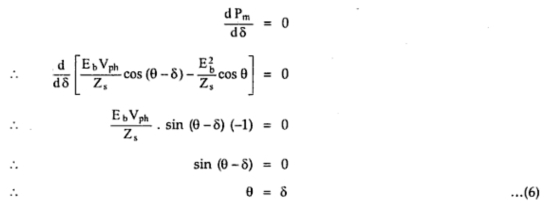The value of δ for which the mechanical power developed is maximum can be obtained as,
but θ = δ for Pm = (Pm)max
Substitute cosθ = Ra/Zs
This is the required condition of excitation.
Note : Note that this is not maximum value of but this is the value of foe which power developed is maximum.
The corresponding value of maximum power is,
Note : Thus when Ra is negligible, θ = 90o for maximum power developed. The corresponding torque is called pull out torque.
1.1 The Value of Maximum Power Developed
The value of maximum power developed can be obtained by substituting θ =δ in the equation of Pm.
When Ra is negligible, θ = 90o and cos (θ) = 0 hence,
When Ra is negligible, θ = 90o and cos (θ) = 0 hence,
... Ra = Zs cosθ and Xs = Zs sinθ
Substituting cosθ = Ra/Zs in equation (6b) we get,
Solving the above quadratic in Eb we get,
Solving the above quadratic in Eb we get,
As Eb is completely dependent on excitation, the equation (8) gives the excitation limits for any load for a synchronous motor. If the excitation exceeds this limit, the motor falls out of step.
1.2 Condition for Excitation When Motor Develops (Pm ) Rmax
Let us find excitation condition for maximum power developed. The excitation controls Eb. Hence the condition of excitation can be obtained as,
Assume load constant hence δ constant.but θ = δ for Pm = (Pm)max
Substitute cosθ = Ra/Zs
This is the required condition of excitation.
Note : Note that this is not maximum value of but this is the value of foe which power developed is maximum.
The corresponding value of maximum power is,










No comments:
Post a Comment